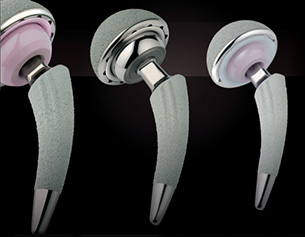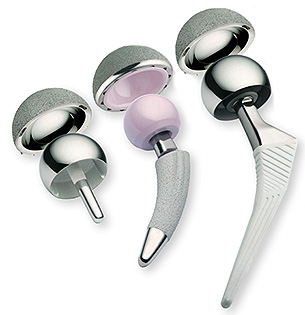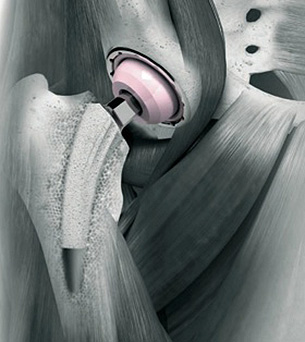
As well as the attraction of a short stem to the femoral component, a significant attraction of the microplasty is its modularity. This photograph shows three microplasties of similar design but where modularity is evident. The component on the right has a ceramic ball articulating with a plastic liner in the hip socket component. The microplasty in the centre has a metal-on-metal articulation, while the microplasty on the left has a ceramic-on-ceramic articulation. This modularity gives the surgeon plenty of flexibility during the operation to cater for unexpected findings.

A resurfacing (left) alongside a microplasty (centre) alongside a total hip replacement (right). Note that the microplasty and total hip replacement are modular while the resurfacing is not. Note also how much shorter is the femoral stem for the microplasty when compared with the total hip replacement and how much more femur bone the former saves at surgery as a result.
 The term microplasty is given to a design of hip replacement that has a particularly short stem to its femoral component. The object is to preserve as much of the femur bone as possible at surgery, as this allows the possibility of a more traditional hip replacement in the years to come. The microplasty is sometimes called a minihip or a stubby stem and is available in a number of different designs.
The term microplasty is given to a design of hip replacement that has a particularly short stem to its femoral component. The object is to preserve as much of the femur bone as possible at surgery, as this allows the possibility of a more traditional hip replacement in the years to come. The microplasty is sometimes called a minihip or a stubby stem and is available in a number of different designs.
The occasion when a microplasty is likely to be used is in the younger, more active patient who is unsuitable for a full hip resurfacing. For example, if the ball of the hip joint is too deformed, it is difficult, if not impossible, to accurately apply a resurfacing component to it. It is better to accept that a resurfacing will not succeed and proceed directly to a microplasty.
A significant attraction of a microplasty is that it is modular. That is, its components come in separate parts, which are assembled during surgery to create the final product. For example the stem of the femoral component, which may be cemented or cementless, is separate from the ball, while the latter is available in a variety of different materials. These can be ceramic or metallic. The ball is also available in different diameters, thereby allowing the surgeon to adjust for hip stability and leg length, although these are always difficult to guarantee.
Meanwhile the hip socket component of a microplasty is the same as that used for a full total hip replacement but it, too, is often modular. This means that the outermost part of the socket component (the shell) is made of metal and the innermost part (the liner) may be made of ceramic or polyethylene of different designs. The liner clips into the shell as surgery proceeds. The attraction of a polyethylene liner is that it allows the surgeon to modify the surgical technique and liner design during the operation, so as to best compensate for any unexpected findings. For example, occasionally a hip can appear to be unstable as surgery proceeds, giving rise to a risk of dislocation once the patient starts to walk. By the judicious use of a specially designed liner, combined with a large-diameter ball, it is sometimes possible to reduce the risk of post-operative dislocation. Because of its shorter stem, a microplasty removes less bone from the upper femur than a full total hip replacement. The attractions are clear.
In truth, a microplasty probably removes a little more bone from the patient than a full hip resurfacing, but the difference is not great, while the benefits of the greater surgical flexibility offered by the microplasty are seen by many as being adequate compensation for the small excess of bone that is removed. A resurfacing can be quite a demanding operation and, because it is not modular, gives the surgeon less chance to undertake final adjustments if faced with an unexpected finding during the operation.
